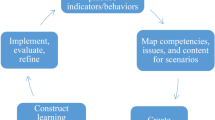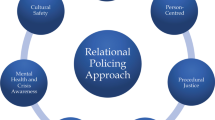Abstract
This research examines the viability of using reentry simulations as a tool for influencing changes in participants’ perspectives about the realities of coming back in the community after a period of incarceration. Using both quantitative and qualitative methodologies, we investigated changes in attitudes toward offenders after participants completed a reentry simulation designed to replicate the experience of the first four weeks in the life of a person attempting to reenter society after incarceration. Participants were 27 students enrolled in a community corrections course that was cross listed and co-taught between criminal justice and social work. Participants completed a quantitative pre- and post-test that assessed attitudes toward prisoners as well as a reflection assignment about the simulation experience. Wilcoxon Signed Rank Test was used to analyze scores from pre- and post-tests. Qualitative analysis of the reflection papers identified and analyzed themes. Both quantitative and qualitative analysis indicate that simulations humanize perspectives toward former offenders and develop a better understanding of their situation. This understanding creates empathetic feelings that can reduce discrimination and stigma, thereby creating an environment more conducive to successful reintegration. Based on the results of this study, use of simulation-based training is recommended with audiences including criminal justice personnel, service providers, court practitioners, judges, and legislators as a way to more clearly articulate the realities faced by this vulnerable population.
Similar content being viewed by others
Notes
To make matters worse, in 2019, the state where this reentry was conducted moved the Probation and Parole services from the county where the greatest number of probationers and parolees live to a neighboring county. The probationers and parolees are required to acquire their own transportation without access to adequate public transportation.
References
Batson, D. C., Polycarpou, M. P., Harmon-Jones, E., Imhoff, H. J., Mitchener, E. C., Bednar, L., Klein, T. R., & Highberger, L. (1997). Empathy and attitudes: Can feeling for a member of a stigmatized group improve feelings toward the group? Journal of Personality and Social Psychology, 72, 105–118.
Batson, C. D., Chang, J., Orr, R., & Rowland, J. (2002). Empathy, attitudes, and action: Can feeling for a member of a stigmatized group motivate one to help the group? Personality and Social Psychology Bulletin, 28(12), 1656–1666.
Birzer, M. L. (2008). What makes a good police officer? Phenomenological reflections from the African-American community. Police Practice and Research, 9(3), 199–212.
Boag, E. M., & Wilson, D. (2014). Inside experience: Engagement empathy and prejudice towards prisoners. Journal of Criminal Psychology, 4(1), 33–43.
Braman, D. (2007). Doing time on the outside: Incarceration and family life in urban America. Dearborn: University of Michigan Press.
Chenault, S., Martin, J., & Matusiak, R. E. (2016). The ripple effect: Empathy statements of participants of an impact of crime on victims class. Corrections, 1(3), 196–214.
Clear, T. R. (2007). Imprisoning communities: How mass incarceration makes disadvantaged neighborhoods worse. Oxford: Oxford University Press.
Cleary, A., Ames, A., Kostadintcheva, K., & Muller, H. (2012). Surveying prisoner crime reduction: Wave 2 (pre-release) samples 1 and 2 technical report. Ministry of Justice Research Series 6/12. Retrieved from http://www.justice.gov.uk/downloads/publications/research-and-analysis/moj-research/surveying-prisoner-crime-reduction-wave-2.pdf. Accessed 15 Mar 2019
Courtright, K. E., Mackey, D. A., & Packard, S. H. (April 2005). Empathy among college students and criminal justice majors: Identifying predispositional traits and the role of education. Journal of Criminal Justice Education, 16(1), 125–144.
Davis, M. H. (1996). Empathy: A social psychological approach. Boulder: Westview Press.
Eisen, L. B., and Chettair, I. (2016). 39% of prisoners should not be in prison. Retrieved from: http://time.com/4596081/incarceration-report/. Accessed Mar 12 2019
Everhart, R. (2016). Teaching tools to improve the development of empathy in service-learning students. Journal of Higher Education Outreach and Engagement, 20(2), 129.
Giovannoni, J., McCoy, K. T., Mays, M., Musco, S. P., & Watson, J. (2015). Probation officers reduce their stress by cultivating the practice of loving-kindness with self and others. International Journal of Caring Sciences, 8(2), 325–343.
Hirschfield, P. J., & Piquero, A. P. (2010). Normalization and legitimation: Modeling stigmatizing attitudes toward ex-offenders. Criminology, 4(1), 27–22.
Hogue, T. E. (1993). Attitudes toward prisoners and sexual offenders. In DCLP Occasional papers: Sexual offenders. Edited by Clark, N. C., and Stepenson G. Leicester UK: British Psychological Society.
Hsieh, H. F., & Shannon, S. (2005). Three approaches to qualitative content analysis. Qualitative Health Research, 15(9), 1277–1288.
Keena, L., & Krieger-Sample, L. (2018). Empathy-focused learning: Teaching criminal justice students to care. American Journal of Criminal Justice, 43, 389–410.
Kjelsbert, E., Skoglund, T. H., & Rustad, A. B. (2007). Attitudes towards prisoners, as reported. BMC Public Health, 7, 71.
Melvin, K. B., Gramling, L. K., & Gardner, W. M. (1985). A scale to measure attitudes toward prisoners. Criminal Justice and Behavior, 12(2), 241–253.
Myrick, R. D., & Erney, T. (1985). Youth helping youth: A handbook for training peer facilitators. Minneapolis: Education Media Corporation.
Myyry, L., & Helkama, K. (2001). University students value priorities and emotional empathy. Educational Psychology, 21, 25–40.
Ortet-Fabregat, G., Perez, J., & Lewis, R. (1993). Measuring attitudes toward prisoners – A psychometric assessment. Criminal Justice and Behavior, 20, 190–198.
Parra, A. (2013). Cognitive and emotional empathy in relation to five paranormal/anomalous experiences. North American Journal of Psychology, 15(3), 401–612.
Poorman, P. B. (2002). Biography and role playing: Fostering empathy in abnormal psychology. Teaching of Psychology, 29(1), 32–36.
Author information
Authors and Affiliations
Corresponding author
Additional information
Publisher’s Note
Springer Nature remains neutral with regard to jurisdictional claims in published maps and institutional affiliations.
Rights and permissions
About this article
Cite this article
Moak, S.C., Walker, J.T., Earwood, M. et al. Using Reentry Simulations to Promote Changes in Attitude toward Offenders: Experiential Learning to Promote Successful Reentry. Am J Crim Just 45, 126–144 (2020). https://doi.org/10.1007/s12103-019-09500-9
Received:
Accepted:
Published:
Issue Date:
DOI: https://doi.org/10.1007/s12103-019-09500-9




